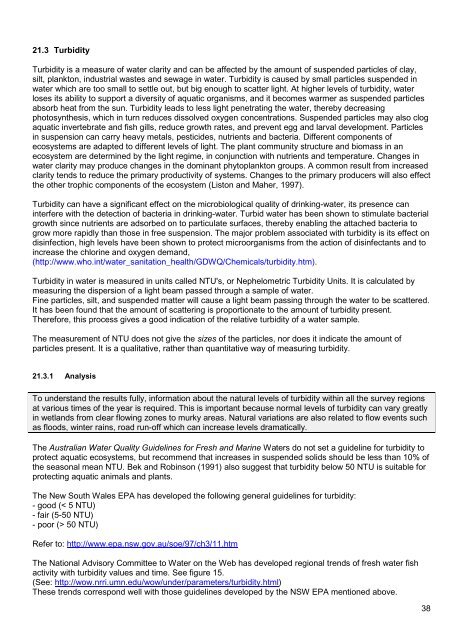2007 Wetland Inventory for the Eyre Peninsula
2007 Wetland Inventory for the Eyre Peninsula
2007 Wetland Inventory for the Eyre Peninsula
- No tags were found...
You also want an ePaper? Increase the reach of your titles
YUMPU automatically turns print PDFs into web optimized ePapers that Google loves.
21.3 TurbidityTurbidity is a measure of water clarity and can be affected by <strong>the</strong> amount of suspended particles of clay,silt, plankton, industrial wastes and sewage in water. Turbidity is caused by small particles suspended inwater which are too small to settle out, but big enough to scatter light. At higher levels of turbidity, waterloses its ability to support a diversity of aquatic organisms, and it becomes warmer as suspended particlesabsorb heat from <strong>the</strong> sun. Turbidity leads to less light penetrating <strong>the</strong> water, <strong>the</strong>reby decreasingphotosyn<strong>the</strong>sis, which in turn reduces dissolved oxygen concentrations. Suspended particles may also clogaquatic invertebrate and fish gills, reduce growth rates, and prevent egg and larval development. Particlesin suspension can carry heavy metals, pesticides, nutrients and bacteria. Different components ofecosystems are adapted to different levels of light. The plant community structure and biomass in anecosystem are determined by <strong>the</strong> light regime, in conjunction with nutrients and temperature. Changes inwater clarity may produce changes in <strong>the</strong> dominant phytoplankton groups. A common result from increasedclarity tends to reduce <strong>the</strong> primary productivity of systems. Changes to <strong>the</strong> primary producers will also effect<strong>the</strong> o<strong>the</strong>r trophic components of <strong>the</strong> ecosystem (Liston and Maher, 1997).Turbidity can have a significant effect on <strong>the</strong> microbiological quality of drinking-water, its presence caninterfere with <strong>the</strong> detection of bacteria in drinking-water. Turbid water has been shown to stimulate bacterialgrowth since nutrients are adsorbed on to particulate surfaces, <strong>the</strong>reby enabling <strong>the</strong> attached bacteria togrow more rapidly than those in free suspension. The major problem associated with turbidity is its effect ondisinfection, high levels have been shown to protect microorganisms from <strong>the</strong> action of disinfectants and toincrease <strong>the</strong> chlorine and oxygen demand,(http://www.who.int/water_sanitation_health/GDWQ/Chemicals/turbidity.htm).Turbidity in water is measured in units called NTU's, or Nephelometric Turbidity Units. It is calculated bymeasuring <strong>the</strong> dispersion of a light beam passed through a sample of water.Fine particles, silt, and suspended matter will cause a light beam passing through <strong>the</strong> water to be scattered.It has been found that <strong>the</strong> amount of scattering is proportionate to <strong>the</strong> amount of turbidity present.There<strong>for</strong>e, this process gives a good indication of <strong>the</strong> relative turbidity of a water sample.The measurement of NTU does not give <strong>the</strong> sizes of <strong>the</strong> particles, nor does it indicate <strong>the</strong> amount ofparticles present. It is a qualitative, ra<strong>the</strong>r than quantitative way of measuring turbidity.21.3.1 AnalysisTo understand <strong>the</strong> results fully, in<strong>for</strong>mation about <strong>the</strong> natural levels of turbidity within all <strong>the</strong> survey regionsat various times of <strong>the</strong> year is required. This is important because normal levels of turbidity can vary greatlyin wetlands from clear flowing zones to murky areas. Natural variations are also related to flow events suchas floods, winter rains, road run-off which can increase levels dramatically.The Australian Water Quality Guidelines <strong>for</strong> Fresh and Marine Waters do not set a guideline <strong>for</strong> turbidity toprotect aquatic ecosystems, but recommend that increases in suspended solids should be less than 10% of<strong>the</strong> seasonal mean NTU. Bek and Robinson (1991) also suggest that turbidity below 50 NTU is suitable <strong>for</strong>protecting aquatic animals and plants.The New South Wales EPA has developed <strong>the</strong> following general guidelines <strong>for</strong> turbidity:- good (< 5 NTU)- fair (5-50 NTU)- poor (> 50 NTU)Refer to: http://www.epa.nsw.gov.au/soe/97/ch3/11.htmThe National Advisory Committee to Water on <strong>the</strong> Web has developed regional trends of fresh water fishactivity with turbidity values and time. See figure 15.(See: http://wow.nrri.umn.edu/wow/under/parameters/turbidity.html)These trends correspond well with those guidelines developed by <strong>the</strong> NSW EPA mentioned above.38
















